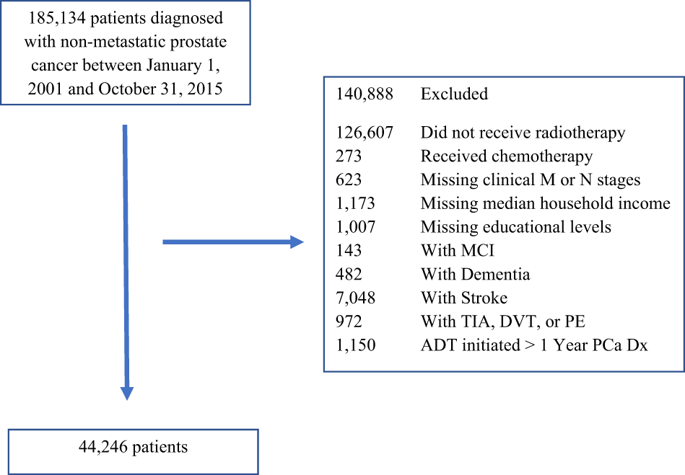Prostate Cancer and Prostatic Diseases ( IF 5.1 ) Pub Date : 2019-04-15 , DOI: 10.1038/s41391-019-0150-5 Rishi Deka 1, 2 , Daniel R Simpson 1, 2 , Matthew S Panizzon 3, 4, 5 , Richard L Hauger 1, 3, 4, 5 , Paul Riviere 1, 2 , Vinit Nalawade 1, 2 , Rana McKay 1, 2 , James D Murphy 1, 2 , Brent S Rose 1, 2

|
Background
There is conflicting evidence regarding the association between androgen deprivation therapy (ADT) for prostate cancer (PC) and the risk of developing stroke and thromboembolic events. Our study evaluated the association between ADT use and development of stroke, transient ischemic attack (TIA), deep vein thrombosis (DVT), and pulmonary embolism (PE) in a homogenous group of men with PC treated with definitive radiation therapy (RT) after controlling for multiple sources of confounding.
Methods
Observational cohort study of patients diagnosed with PC at the US Department of Veterans Affairs between 1 January 2001 and October 31, 2015 and treated with definitive RT. Exposure was initiation of ADT within 1 year of PC diagnosis. Primary outcomes were development of stroke, TIA, DVT, or PE.
Results
44,246 men with median follow-up of 6.8 years. The overall cumulative incidences of stroke, TIA, DVT, and PE at 10 years were 6.0, 3.0, 3.4, and 1.9%, respectively. In the multivariable competing risks model, there was a significant association between ADT and stroke (subdistribution hazard ratio (SHR) = 1.19, 95% CI = 1.09–1.30, p < 0.01), TIA (SHR = 1.24, 95% CI = 1.08–1.41, p < 0.01), and DVT (SHR = 1.18, 95% CI = 1.04–1.34, p < 0.01). ADT was only associated with PE in men receiving ADT for > 1 year (SHR = 1.34, 95% CI = 1.06–1.69, p-value = 0.03).
Conclusion
We observed an increase in the risk of stroke, TIA, and DVT in men receiving ADT and an increased risk of PE in men receiving long-term ADT. These results highlight concerns regarding long-term risks of ADT on stroke and thromboembolic events in the treatment of PC.
中文翻译:

接受或不接受雄激素剥夺治疗的明确放射治疗的前列腺癌男性中风和血栓栓塞事件。
背景
关于前列腺癌 (PC) 的雄激素剥夺疗法 (ADT) 与发生中风和血栓栓塞事件的风险之间存在相互矛盾的证据。我们的研究评估了 ADT 的使用与卒中、短暂性脑缺血发作 (TIA)、深静脉血栓形成 (DVT) 和肺栓塞 (PE) 的相关性,这些患者在接受明确放射治疗 (RT) 后接受明确放射治疗 (RT) 的 PC 男性同质组中控制多种混杂来源。
方法
对 2001 年 1 月 1 日至 2015 年 10 月 31 日期间在美国退伍军人事务部诊断为 PC 并接受根治性放疗治疗的患者进行的观察性队列研究。暴露是在 PC 诊断后 1 年内开始 ADT。主要结局是卒中、TIA、DVT 或 PE。
结果
44,246 名男性,中位随访时间为 6.8 年。10 年卒中、TIA、DVT 和 PE 的总体累积发生率分别为 6.0、3.0、3.4 和 1.9%。在多变量竞争风险模型中,ADT 与卒中之间存在显着关联(子分布风险比 (SHR) = 1.19, 95% CI = 1.09–1.30, p < 0.01)、TIA (SHR = 1.24, 95% CI = 1.08 –1.41, p < 0.01) 和 DVT (SHR = 1.18, 95% CI = 1.04–1.34, p < 0.01)。在接受 ADT 超过 1 年的男性中,ADT 仅与 PE 相关(SHR = 1.34, 95% CI = 1.06–1.69, p值 = 0.03)。
结论
我们观察到接受 ADT 的男性中风、TIA 和 DVT 的风险增加,而接受长期 ADT 的男性发生 PE 的风险增加。这些结果突出了对 ADT 对 PC 治疗中卒中和血栓栓塞事件的长期风险的担忧。











































 京公网安备 11010802027423号
京公网安备 11010802027423号